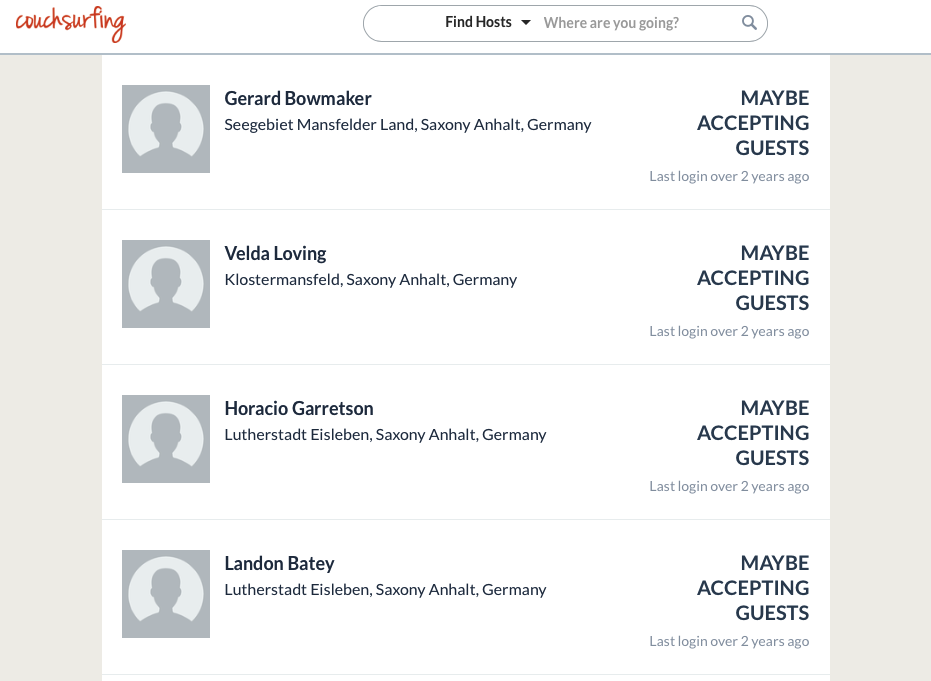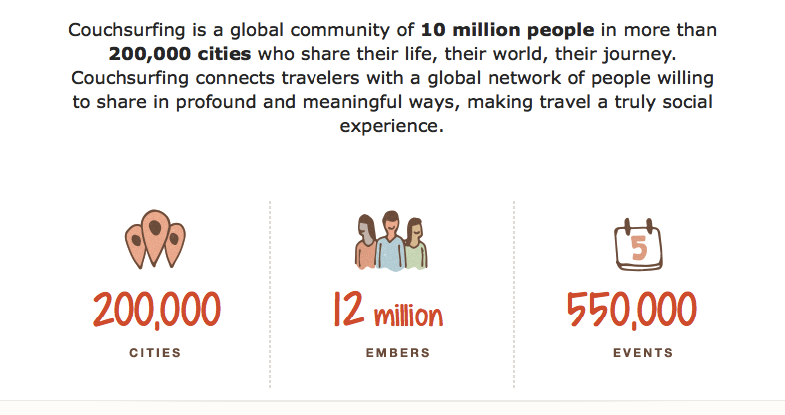About 4 weeks ago I went back to my hometown to stay with my family before going on a bigger trip in the upcoming months. Because I have largely lost connection to my old friends from school, I was randomly searching for people in my hometown to meet up with. I come from Eisleben, which is a 25.000 people town in the heart of Germany. I was really surprised when I checked the host search on Couchsurfing for Eisleben. It lists 8 pages of results with a total of 117 hosts. I had conducted a similar search some years ago, back then it showed about 8 members. All profiles were real. I did not expect any more in this little town, since we have no college or whatever, it is not very attractive to international people.

Almost 100 internationals in and around a countryside town in Germany?
When I checked the 117 hosts it turned out that out of the 117 only 18 had a picture and another handful had actual German names. At the same a lot of profiles had English sounding names like Van Connors or Melissa Galway. That would not be unusual if we wouldn’t be talking about my hometown. There are foreigners here, but they come as tourists (we are the birthplace of Martin Luther) and hardly stay a day in town. The ONLY English speaking person living in Eisleben that I can remember, was the pastor of our local church who came here from Chicago! So a huge number of people with English names is highly unlikely. I did check when the profiles were created: All said that the „Last login“ was „over 2 years ago“. Now that is around 2013 to 2014.
Other destinations show empty profiles too
To countercheck my suspicion I started looking for data that provided similar evidence in random places around the world. While there seem to be 140.000 profiles around New York City I could find pages of profiles with names, no photos, no login, no information and Couch status set to „Maybe accepting guests“ all created between 2 and 4 years ago. Same in towns in Lithuania, Russia etc. Here I could also notice a weird phenomena. In Petropavlosk-Kamchatskiy, a town on Russia’s Kamchatka peninsula I found those same 2 year old profiles as empty as the other ones with Russian names transcribed into Latin letters. I also found a large number of empty profiles with typical Lithuanian names in Alytus, Lithuania. Those were the searches that I conducted. I am sure the same would happen elsewhere. While the fact that those profiles exist is nothing strange, the actual number of them is.

Advertising with inflated numbers of fake profiles
Just to check, I also looked at destinations Couchsurfing suggests to me. CS advertises on its page to have 4000 available couches in Gold Coast, Australia. However, if you go to the last pages of the search you already find only those empty profiles as described before. I also started scrolling through the Couchsearch for Gold Coast from the beginning. On page 20 of the results, the fake profiles start to be the majority. There is a total of 231 pages with 20 profiles each. For me profiles are inactive after one week of no login. So I set filters. Since I also do not login sometimes for 2 weeks or even a bit more I set the filter for a Last login to have been within a month, which shows at least a bit of activity on CS. Even with this fair approach the number of available hosts in Gold Coast goes down to 303 members.
Statistics show a huge increase in 2013
While I have met many people in my 10 years using Couchsurfing, some of the people have not logged in a couple of years. They are still in searches too. But they have photos and references. Those profiles in Eisleben or Gold Coast do not. Because I was looking for facts to support this evidence I happened to find a recent blogpost from computer scientist Max Klein from the States who found evidence for the increase of profile creation with no references or verification around the year 2013. He doesn’t say how he gathered the number but I have written to him to confirm it.
He also suggests that those fake profiles were created after Couchsurfing has received investments from several capital firms. All together it was around 22 millions that CS received. Before they had been claiming to found a non-profit but founder Casey Fenton said that the IRS had not approved the 501c(3) non-profit status for Couchsurfing. So he ended up making it a so-called B-Corp that is supposed to be „socially responsible“. He received investments from several capital firms, one being also investors at Airbnb.

Couchsurfing at least tolerates spam profiles and uses them for advertising
I don’t want to suggest that Couchsurfing has created fake profiles to gain attention and attract people to register on the site. It could just have been a spambot who used those profiles to send out automated messages. But it is at least clearly visible that Couchsurfing does tolerate those spam profiles. Couchsurfing also does like to claim a high number of users (currently it advertises 12 million), since this is critical to a service that wants to provide „free accommodation worldwide“. I personally have not seen an increase in the usage of Couchsurfing as well in activity as in personal requests or couches. Activity has rather decreased since the heydays from 2008 to 2011. So has the quality of requests for my couch.
If however evidence suggests that these profiles were even created intentionally, Couchsurfing could face legal trouble. In Germany the founders of the dating app Lovoo have just been busted for supposedly creating fake profiles and even using them to communicate with members and trigger them to use paid services. The founders of Lovoo are now facing a trial for fraud.
Couchsurfing needs to clear it’s database from fake profiles
The least the management of Couchsurfing can finally do, is to clear the Couchsearch and database of all fake profiles. Also people who have not logged in for over 2 or at least 3 years are not very likely to return. I suggest a mailing action to those members to either log in to remain or have their profile suspended and taken out of the search results within a certain period of time. CS also needs to communicate an accurate number of its active members. Couchsurfing owes this to them, the investors and the public sphere. This would be worth the trust that it asks from it’s members.
Disclaimer: Peter Althaus has been a member of Couchsurfing for 10 years and has served as an ambassador to the Couchsurfing community. He was supporting CS to become a non-profit organisation and ceased volunteer work after CS announced to become a B-Corp and received investments.



Indeed Peter, the phenomena of computer-generated profiles has been discovered independently by users several times. When it was brought to the attention of CS management concerning a small Swedish town, they immediately erased the fake profiles. When it was pointed out that the phenomena was widespread, they went silent.
There seem to be more than a single algorithm used to generate the fake profiles. But in at least one case, the person or persons responsible is even more incompetent than you indicate.
Besides using a US-based name list to generate the profiles, they also randomly assigned the gender of the profiles, so that half have genders that do not match gendered names.
In at least one series of fake profiles, they also used an automated computer process to create fake biographical content.
Profiles were also created using url addresses that did not correspond to the profile location. They seem to have been created using well-known proxy servers.
All in all, the responsible parties would appear to have limited computer and conceptual skills. But since this has long been true of CS management, it is difficult to say what that means about the guilty parties.
Since there is no continuity in CS management, it is quite possible that present management has no information at all – and for legal reasons prefers to not investigate themselves. Ignorance can be an effective defense against wrongdoing.
A further note. Since the CS platform was re-written and downgraded in November 2014, it has been more difficult to identify the fake profiles, since less information is available to users.
As said I also suggest it rather is ignorance. But there would be the possibility to take care of those profiles and they simply don’t. Thanks for the other infos. Could not find any information on that fake profile wave since CS deleted the original post concerning this topic.
Consumers have little protection against advertising fraud. The trans-Atlantic treaty that is being secretly negotiated at this moment will clearly worsen that situation, designed as it is by business interests and without participation of consumer groups.
In the CS case, I believe the likely real target of the computer-generated fake targets was not the consumer, but rather possible investors or active investors. And in that case, fraud charges may carry more weight. When you knowingly make false claims to potential investors, that is taken much more seriously in the US than protecting consumers.
But since CS has been unable to find new investment money, there is no „harmed party“, limiting the possibilities for legal action. If the perpetrator is a present or past employee or stock holder acting individually, as has been suggested, then the wronged parties could include other stock holders.
It would indeed be reasonably easy for CS management to identify and erase these robot-created profiles – a large portion of them all share a series of give-away clues that could be easily found by using simple search tools inside the CS database. Since none of them have ever been active, there is no potential downside.
Except as you mention, to maintaining false numbers concerning membership.
Even CS has recently publicly presented figures that show their active membership to be a tiny fraction of the membership numbers it claims. In 2011, Casey Fenton already publicly stated that he thought about one third of members were active. That number has clearly decreased radically, since new members are less likely to become involved, and as the number of „years inactive“ increases for more and more members.
And as you point out, an examination of members in any location immediately reveals that the vast majority of profiles have never actively participated in any way. Even more telling, even among people who are listed as „verified“ (who CS in their Terms of Use makes clear have not actually been verified in any way whatsoever) and paid for that status, a majority in most locations have no references for hosting or surfing.
The upside of this situation (for the few who seek information) is that the obvious disinterest in honesty by CS management, even when the situation has been acknowledged by CS itself (as with some of these fake profiles), helps people realize that in even more important questions – I’m thinking specifically about user safety – informed members will realize that CS management statements cannot be trusted.
Einfach nur ne Schande, wie sie die tolle Community durch das aggressive Anwerben von neuen Mitgliedern und die Fake-Profile kaputt gemacht haben….
Ja, das finde ich leider auch. Das Problem ist auch bekannt, trotzdem wird da nichts gemacht.
Another interesting thing I found was that often couchsurfers who had a public trip planned had cs friends listed who had the exact trip , same dates and same name. Curious.